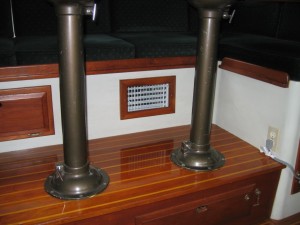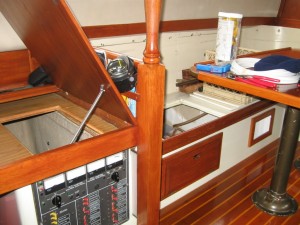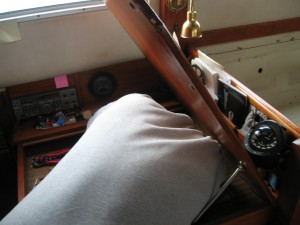Project: Heat Pump Permanent Wiring Yoga
There… over there on the right hand side of the picture, near the bottom… See that grey power cord snaking out of the compartment under the dinette seating? That has been our “permanent power wiring” for the heat pump since we installed it last winter.
Now, it is a proven Law Of Nature that the incentive for completing a project is proportional to the amount of the project remaining. Thus, you can approach project completion, but it is difficult to actually get there. This is one of those items. I have been “temporarily” supplying power to the heat pump by plugging it in to a convenient outlet, for a year.
In order to properly wire the heat pump, it needed to have its own breaker in the power panel. And a decision had to be made as to whether to supply the heat pump thru the inverter, or direct from the mains. And since the wiring for the water heater had a PO splice in it and was conveniently nearby, it needed to be replaced too.
But first: power thru the inverter or not? Although the inverter can power the heat pump (I tried it), we would never do that – the battery load is unsustainable. So then, why would I choose to power it thru the inverter, as that was the final decision? The reasoning went like this:
- We have significant 12V loads on Eolian, even when plugged into shore power. Most notably refrigeration
- Significant 12V loads mean that the battery charger will be needed frequently, and will need to deliver significant power – not just a trickle charge.
- In turn, this means the battery charger will require significant amounts of power.
- The battery charger is actually part of the inverter, a perfect convergence of function
- Our Heart inverter has a “power sharing” function. That is, you can program the inverter/charger to use a maximum amount of 110V power to supply its loads (including the integrated battery charger). If the need increases beyond the power sharing setting, the amount of power available to the battery charger is reduced.
- Loads which are not supplied thru the inverter are unknown to it. Our water heater is wired direct to the mains, and draws about 10 amps. Therefore the inverter has been programmed to take no more than 20 amps for its needs, to avoid exceeding our 30 amp total load maximum.
- If I were to have powered the heat pump direct, I would have had to reduce the load sharing setting to 5 amps, since the heat pump draws 12 amps ( the load sharing is in 5 amp increments – there is no 8 amp setting)
- 5 amps is not a reasonable amount of power to share amongst the battery charger and all the power outlets on board.
- By powering the heat pump thru the inverter, I can leave the power sharing setting at 20 amps. If the heat pump is running, there will be a maximum of 8 amps available to the battery charger – not enough to run refrigeration, so at least part of the refrigeration load will come out of the batteries. But as soon as the heat pump shuts off, the battery charger wants the full 20 amps to replenish the batteries.
This was a good decision – it works well. In fact, by running for a year with our “temporary” setup, we were already running thru the inverter, since the outlets are powered that way. We have had a successful one-year trial.
Now for implementation. The under-seating compartments all had to be completely emptied. The heat pump is in the compartment behind the teak-surrounded white grill (far right), the water heater is in the next compartment to the left (with the solid teak door), and the power panel is below the nav station desktop (accessible only thru the small opening, awkwardly oriented the wrong way).
Stringing the wire was not difficult, nor was terminating it at the water heater and the heat pump (other than the joy of wedging my body into those small spaces to do the work). Most of the effort was spent with my head and shoulders down in that small opening in the nav station, reconfiguring the breakers and wiring behind the panel. Jane got a particularly unflattering picture of me, immersed in the work..
So, we have accomplished the impossible: we have reached the asymptote – the project is complete!
Yoga? Who needs it?
To see more stories about Eolian please visit http://windborneinpugetsound.blogspot.com




Recent Comments